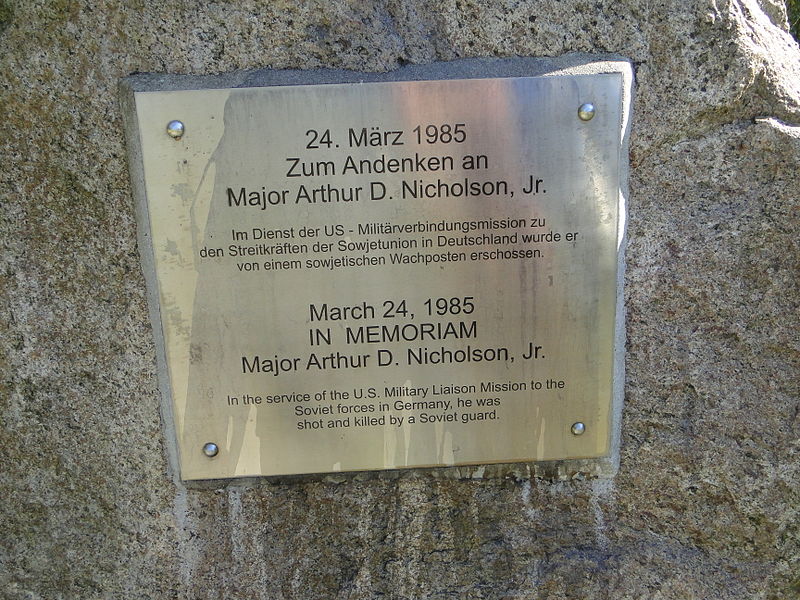Major Arthur D. Nicholson Memorial
Details:
On the south side off the road.
A large bronze plaque affixed to a large pyramidal stone. The plaque is inscribed in German and English in black lettering. It commemorates the death of Major Arthur Nicholson who was shot dead by a Soviet guard.
Major Nicholson was a United States Army military intelligence officer shot by a Soviet sentry while engaged in intelligence-gathering activities as part of an authorized military liaison mission that operated under reciprocal U.S.–Soviet authority. Military liaison missions were ostensibly liaisons between the British, French, and U.S. forces and the Group of Soviet Forces in Germany (East Germany), but they had a known intelligence-gathering secondary mission and an important role to verify that offensive action was not being prepared. Reciprocal groups were authorized and operated by both the British, French, and U.S. (in East Germany) and the Soviet Union (in West Germany) during the Cold War. Nicholson is officially regarded by the U.S. Department of Defense as having been a victim of murder and the final victim of the Cold War. Nicholson's death led to a U.S. – Soviet crisis and intense negotiations regarding the military liaison missions.
On March 24, 1985, with Sergeant Jessie G. Schatz, Nicholson undertook his final mission for the USMLM. The mission was to photograph a Soviet tank storage building near Ludwigslust, some 100 miles northwest of Berlin. After approaching the Soviet facility covertly but legitimately through an adjacent forest, Nicholson stepped out of the vehicle and approached the building to photograph it while Sergeant Schatz maintained a watch for Soviet personnel.
Unseen by either man, Soviet Sergeant Aleksandr Ryabtsev emerged from the forest and opened fire on the Americans. The first bullet narrowly missed Schatz, and another bullet struck Nicholson. After crying out that he had been hit, Nicholson fell to the ground. Attempting to go to Nicholson's aid, Schatz was halted by Ryabtsev at gunpoint and forced back into the USMLM vehicle.
Although the Soviets later claimed that Nicholson died instantly, an autopsy indicated that he had bled to death while on the ground.
Even as more senior Soviet personnel arrived, no medical aid for Nicholson was provided and no one checked his conditions for two hours after he was shot.
After an attempt by the Soviets to perform an autopsy of Nicholson and a demand by General Glenn K. Otis that they return the body, Nicholson's body was returned to the U.S. Army at the Glienicke Bridge in Berlin.
The Soviets contended that the response of Sergeant Ryabtsev, as a guard, had been appropriate in confronting an "unknown intruder who did not comply with the warnings of the sentry", and also stated that the area that Major Nicholson was in was "off-limits" to military liaison mission operations, as well as placing blame for the incident on the United States.
At a subsequent meeting between General Otis and General Mikhail Zaitsev, the commander of Group of Soviet Forces Germany, General Otis made it clear that the U.S. Army believed that Nicholson's murder was "officially condoned, if not directly ordered.
Following this, a Soviet diplomat was ordered out of the U.S. and the U.S. canceled plans to jointly celebrate the 40th anniversary of the end of the Second World War in Europe with the Soviets.
The incident was also the first major foreign policy crisis faced by Mikhail Gorbachev as leader of the Soviet Union. The relatively muted U.S. response drew criticism from various sources, among them George Will.
Further negotiations over the shooting resulted in the Soviets issuing instructions to their personnel that the use of force or weapons against Allied military liaison personnel was strictly forbidden. However, in 1987, another incident took place in which Soviet soldiers fired at USMLM personnel, one of whom was wounded. In 1988, Soviet Defense Minister Dmitry Yazov officially apologized for the death of Major Nicholson to U.S. Defense Secretary Frank C. Carlucci at a summit conference in Moscow.
Source of information: en.wikipedia.org
Source of images: commons.wikimedia.org, www.grabow-erinnerungen.de
Monument Text:
24. März 1985
Zum Andenken an
Major Arthur D. Nicholson, J.r.
Im Dienst der US - Militärverbindungsmission zu
den Streitkräften der Sowjetunion in Deutschland wurde er
von einem sowjetischen Wachposten erschossen.
March 24, 1985
IN MEMORIAM
Major Arthur D. Nicholson, Jr.
In the service of the U.S. Military Liaison Mission to the
Soviet forces in Germany, he was
shot and killed by a Soviet guard.
Commemorates:
People:
Units:
United States Army
Wars:
Cold War
Other images :


